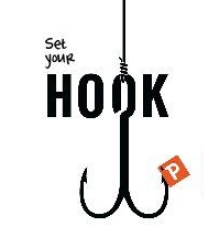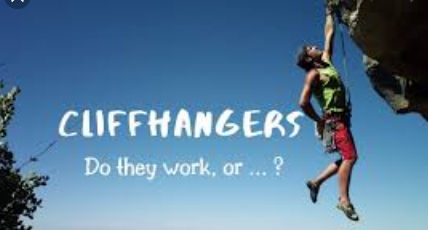The idea of cliffhangers in business content always seemed weird to me. It can be a great way to hook your audiences, yes? Stay tuned to find out how.

Do you think business writing is too serious for that? I don’t.
Business content aims to educate, market, and sell. We’re not writing a Netflix blockbuster. But I have to admit I was wrong.
A cliffhanger adds a touch of drama, and that tiny bit of drama makes even serious business content more engaging. This works for blog posts, and even for sales pages.
Do you want to keep busy readers hooked to your words? Drama is about tension and a curiosity to learn more.
The drama keeps readers spellbound because they want to know what’s happening next. Will the detective find the murderer? Will the shy youngster find love? Who will win this fight?
In fiction, drama can get quite complicated. You need characters that readers can empathize with and root for. You need a plot with twists and turns, so readers stay eager to learn more.
In business writing, we don’t need too many complications. We only need one-sentence cliffhangers to keep readers captivated for a few more paragraphs.
Let’s see how …
Michael Connelly is a bestselling crime writer, known for his series about detective Harry Bosch. He’s also written courtroom dramas about Mickey Haller, Harry’s half-brother, and a defense attorney.
Courtroom dramas can be tricky. As a reader, you may sometimes think: I know what this witness is going to say, this is getting boring. The tiny cliffhanger pokes readers and keeps them engaged. For instance:
Little did I know how important this witness’s testimony would become.

This sentence immediately makes the reader curious: Why is this testimony important? What will it reveal?
Here’s another example, more subtle:
Sometimes the wheels of justice roll smoothly. The second day of the trial started exactly as scheduled.
This sentence makes readers curious as they suspect the second day of trial may not end smoothly. What will happen?
One more example from Connelly:
It was this stack of correspondence that I was most interested in, and it was here that I found the document that would change the course of the case.
Readers want to find out what this document is, and how it changes the course of the case. This curiosity keeps them reading for a few more pages.
We can use the same principle to arouse curiosity in business content and keep our readers captivated for a few more paragraphs—no matter whether we’re writing business stories, blog posts, or sales copy.
Cliffhangers in business storytelling
Mike Sager is an award-winning journalist, who wants to empower creatives to pursue and profit from their work.
His blog posts on 99U.com are a mix of education, inspiration, and a large dose of personal storytelling.
His blog post Knocking Down your Creative Blocks, for instance, starts with this sentence:
This is a story about the day I quit writing.
On its own, this sentence might not make us curious, but we know this post is about writer’s block, and this context makes this sentence fascinating. Why did he quit writing? And how did he get started again? Can I learn something from what the author went through?
Another blog post by Sager—about being an artist in fractious times—starts with the sentence:
I became an artist at the age of 13, when a tear gas canister careened off the cracked asphalt of Reade Street in downtown Baltimore and skidded toward my feet, billowing gray smoke.
I don’t recommend writing a long first sentence because they’re hard to pull off and keep readers engaged, but Sager immediately got me: How did he become an artist at the age of only 13? And why was he in this dangerous situation? And what has the tear gas to do with being an artist? These questions keep me reading on.
The following example from Sager is not the first but the third sentence. In the first two sentences of a blog post titled Creative Careers Demand Reinvention, Sager explains he’s talking to a former student, then he hits us with this:
“I got shit-canned,” he said, his voice like a thousand-yard stare.
In the context of reinvention, this sentence raises questions: Why did his student get fired? What did Sager tell him to do? And how did that help him reinvent his creative career?
One-sentence cliffhangers raise questions. These questions make readers curious, and that’s how you can keep them hanging on to your words. This also works in educational material.
Cliffhangers in “how-to” blog posts
In educational material, the reader is the hero, and the writer is his guide.
The reader is struggling with a problem or dreaming of a better life, and the writer tells him how to get there, how to defeat his demons, and how to achieve his goals.
The drama in educational material is about this tension between what is and what could be. The one-sentence cliffhanger is like a promise of what could be.
For instance, in a blog post about distracted readers and visual thinking, I promise:
But engaging your readers becomes a lot easier when you apply visual thinking tools to your writing.
The idea that visual thinking could solve the problem of distraction is intriguing. What are these visual tools? And how do they help? When these questions resonate with readers, they’ll keep reading on because they want to know the answers.
Here’s another example from a post about writing faster:
In the past years, I’ve read many books about productivity and writing, and I’ve learned a few crazy and counter-intuitive tricks to massively shorten the time it takes me to write good content.
Again, for the right readers, this is intriguing: How did I shorten my writing time? Why are these tricks crazy and counter-intuitive?
To keep business readers captivated, create a sense of mystery or promise them a solution to their problems.
Cliffhangers in sales
In sales, you’ll find one-sentence cliffhangers in testimonials or case studies. For instance:
I signed up for a copywriting course wishing to renew our hopelessly outdated website text. For someone who’s by no stretch of the imagination a copywriter, this was a daunting task.
For readers considering joining this course, this sentence is intriguing. Did the course help make the daunting task doable? Did this participant get rid of her hopelessly outdated website? Was she able to learn how to write copy?
Here’s another example of a one-sentence cliffhanger:
And frankly, I wasn’t sure I could afford it.
This sentence refers to a common hesitation about joining courses because spending money is a risk: Is it worth my investment? Will I really learn something valuable? Will I have the time to commit to this course?
Your best salespeople are the people who have hired you and enjoyed your service. They can tell the best stories. They can write the best sales copy for you. Their one-sentence cliffhangers hook potential customers as they become eager to learn more.
These one-sentence cliffhangers in the testimonials work best when they tap into a wish, fear, frustration, or doubt other potential customers recognize.
The web is full of fluffy content boring readers to tears. Let’s not add more fluff to this giant echo chamber.
Instead, think about your favorite reader …
How could you keep him captivated? What would make him curious to learn more?
When you keep readers spellbound for a blog post, they get addicted to your writing, and they’re bound to come back for more.
The bottom line
As we change at a faster and faster pace, ideas adequate yesterday are no longer are good enough. And with digital disruption facing an increasing number of industries, most firms must come up with the best ideas for change or move to a slow failure. The myths of new ideas must be set aside to let the new idea facts take over.

